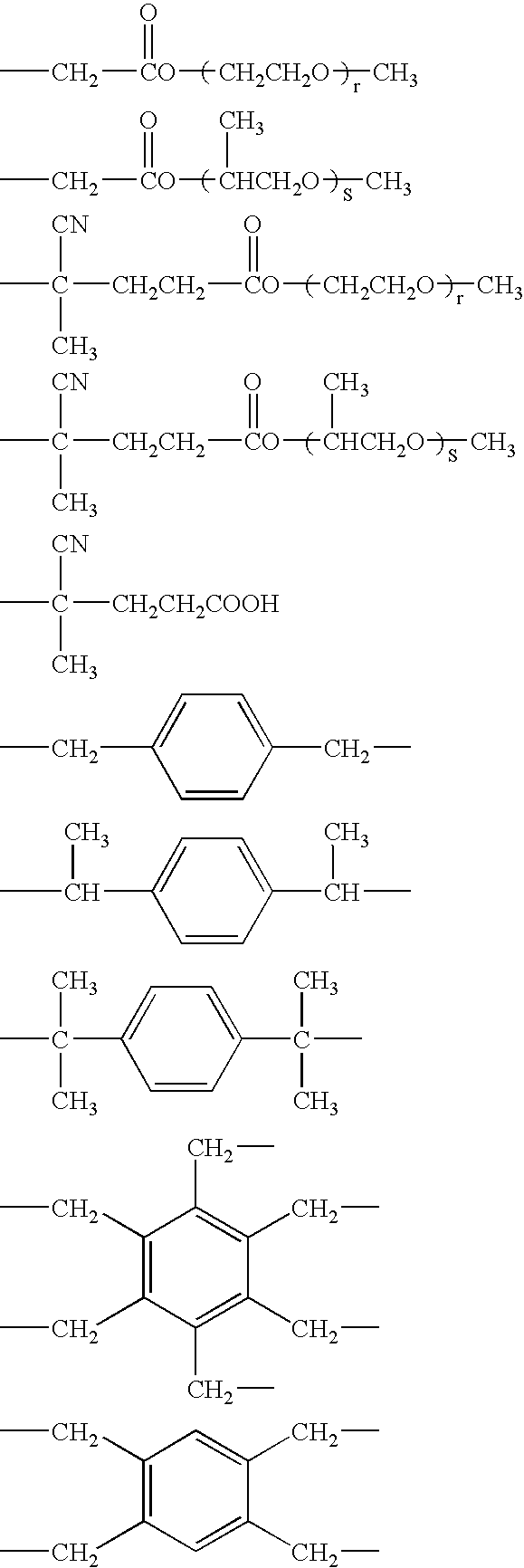Process for producing polymer having crosslinkable silyl group and curable composition
a technology of crosslinking silyl group and polymer, which is applied in the field of producing a crosslinking silyl groupcontaining polymer and a curable composition, can solve the problems of low staining properties, low oil resistance, paintability, gas barrier properties, etc., and achieves low staining properties, low staining properties, and excellent oil resistance. , the effect of low cos
- Summary
- Abstract
- Description
- Claims
- Application Information
AI Technical Summary
Benefits of technology
Problems solved by technology
Method used
Image
Examples
example 1
[0075]Into a 1 L reactor equipped with an agitator, a thermometer, a nitrogen gas inlet tube, and a reflux condenser tube, was placed 181 g of n-butyl acrylate as a vinyl monomer, 40 mg of 1,1′-azobis(1-cyclohexanecarbonitrile) as a polymerization initiator, 635 mg of compound represented by formula (5):
as a thiocarbonylthio group-containing compound, and 300 mL of toluene as a solvent, and the reactor was nitrogen-purged. The reaction solution was heated at 90° C. for 5 hours while being stirred. Toluene was removed from the reaction solution by distillation under reduced pressure. Thereby, 110 g of polymer (Mw=77,000, Mn=56,900, and Mw / Mn=1.35) was produced. 1H NMR measurement confirmed that thiocarbonylthio groups were introduced into both ends of the polymer, and the introduction rate was 93% on the both-ends basis.
[0076]The resultant poly(n-butyl acrylate) having thiocarbonylthio groups at both ends (110 g) was dissolved in 400 mL of toluene, and 30 g of monoethylamine as an a...
example 2
[0080]Into a 1 L reactor equipped with an agitator, a thermometer, a nitrogen gas inlet tube, and a reflux condenser tube, was placed 181 g of n-butyl acrylate as a vinyl monomer, 40 mg of 1,1′-azobis(1-cyclohexanecarbonitrile) as a polymerization initiator, 1.40 g of compound represented by formula (5):
as a thiocarbonylthio group-containing compound, and 300 mL of toluene as a solvent, and the reactor was nitrogen-purged. The reaction solution was heated at 90° C. for 40 hours while being stirred. The reaction liquid was sampled, and GPC measurement confirmed that a polymer (Mw=56,500, Mn=41,100, and Mw / Mn=1.37) was produced. Furthermore, 1H NMR measurement confirmed that thiocarbonylthio groups were introduced into both ends of the polymer, and the introduction rate was 90% on the both-ends basis.
[0081]Next, 30 g of diethylamine as an amine compound was added thereinto, followed by stirring at 30° C. for 8 hours. The remaining diethylamine and toluene were removed by distillation...
example 3
[0084]Into a 1 L reactor equipped with an agitator, a thermometer, a nitrogen gas inlet tube, a reflux condenser tube, and a dropping funnel, was placed 410 mg of sodium dodecylsulfate as an emulsifier and 400 g of distilled water, and the reactor was nitrogen-purged while the mixture was being stirred at 80° C. Next, 1.08 g of compound represented by formula (6):
as a thiocarbonylthio group-containing compound, which was dissolved in 25.6 g of n-butyl acrylate as a vinyl monomer, was added into the reactor, followed by stirring at 80°C. for 20 minutes under nitrogen flow. As a polymerization initiator, 432 mg of 4,4′-azobis(4-cyanovaleric acid) together with 25 g of distilled water was further added thereinto. Stirring was performed at 80° C. for 30 minutes, and then a mixed solution of 51.3 g of n-butyl acrylate and 52.1 g of 2-methoxyethyl acrylate was dripped from the dropping funnel for over 1.5 hours. After dripping was completed, the mixture was stirred at 80° C. for 4 hours,...
PUM
| Property | Measurement | Unit |
|---|---|---|
| boiling point | aaaaa | aaaaa |
| glass transition temperature | aaaaa | aaaaa |
| pressure | aaaaa | aaaaa |
Abstract
Description
Claims
Application Information
 Login to View More
Login to View More - R&D
- Intellectual Property
- Life Sciences
- Materials
- Tech Scout
- Unparalleled Data Quality
- Higher Quality Content
- 60% Fewer Hallucinations
Browse by: Latest US Patents, China's latest patents, Technical Efficacy Thesaurus, Application Domain, Technology Topic, Popular Technical Reports.
© 2025 PatSnap. All rights reserved.Legal|Privacy policy|Modern Slavery Act Transparency Statement|Sitemap|About US| Contact US: help@patsnap.com



